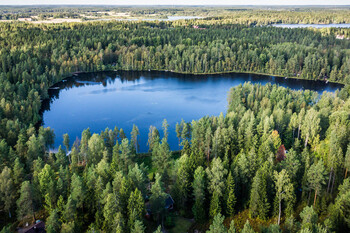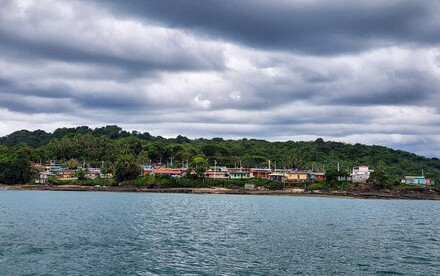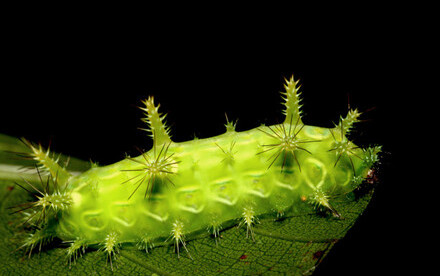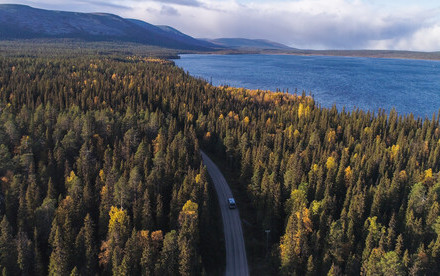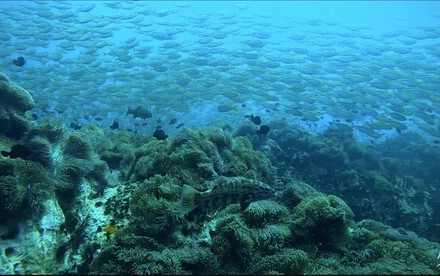09 Apr 2021
What do the Galapagos Islands have in common with ponds in Finland? They are both laboratories, where scientists like HKU’s Professor Juha Merila, can observe evolution in action
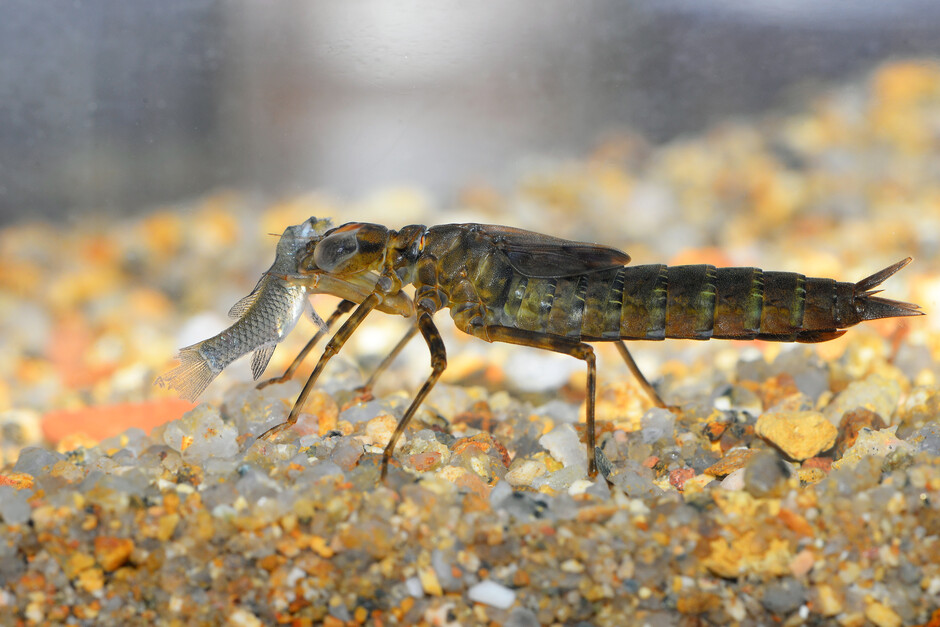
Larva of tiger hawker dragonfly feeding on a small fish. Pelvic spines can deter large marine predators that swallow sticklebacks whole, but in ponds they offer no defense against dragonfly larvae. (Credit: Song Ruibin)
The Galapagos Islands is where Charles Darwin formulated the theory of evolution. Darwin realised that groups of animals of the same species had become stranded on different islands of the Galapagos archipelago and lost contact with each other. In isolation, they evolved into organisms often very different from the original stranded ancestor.
The same process still goes on around us – Professor Juha Merila of the Research Division for Ecology & Biodiversity and the School of Biological Sciences, observed evolution as it takes place, in real time, in ponds in his native Finland.
Finland is a land of lakes and ponds – on the map they look like islands of water in the sea of forest. Just like on the Galapagos, some animals, such as fish and amphibians, are often cut off from their fellow species in other ponds. But unlike the Galapagos, these Finnish “freshwater islands” have no giant tortoises or marine iguanas. Professor Merila observed evolution in small fish, a species known as nine-spined stickleback.
Sticklebacks are very common in the northern hemisphere. Able to live equally well in salt and freshwater, these small fish can move freely between the sea, lakes and rivers. Over the millennia, populations of sticklebacks become cut off from their “mother populations” in the sea. Trapped in a small lake or a pond, sticklebacks found themselves in a very different environment.
One of the changes probably came as a relief to sticklebacks – unlike the sea, the small Finnish ponds have no large predatory fish that can gobble up them up in one go. In the sea, the sticklebacks’ natural defence against fish predators are two large, sharp pelvic spines – if you grab a stickleback, it will immediately stick them out perpendicularly to its bodyline, making itself very hard to swallow.
In the ponds where Merila did his research, there are no such large predators, and the pelvic spines offer no advantage. They are also heavy, and pond sticklebacks have been shedding this load. They do so by losing their pelvis that the spines are part of.
Losing your pelvis, a major skeletal structure, also means losing your legs. About fourteen million years ago, lizards did just that, giving rise to legless snakes. But some snakes, such as pythons, still have remnants of legs, now reduced to a pair of claws. These claws are the equivalent of stickleback’s pelvic spines.
The gene responsible for the pelvis loss and reduction in sticklebacks has been known for years, and is called Pitx1. The same gene is also present in humans, and is thought to be tied to a condition known as club foot.
Merila’s research, however, showed that in nine-spined stickleback populations in isolated ponds in Finland, not only Pitx1, but several other genes are also involved in loss or reduction of pelvis. Merila adds that we still do not know what those genes are.
Merila explains that populations of sticklebacks that he studied in Finland have no contact with each other – fish are unable to travel from pond to pond over land. This means that there is no gene flow between populations in different ponds. Gene flow enriches genetic material of a population by giving the evolution more gene variants to work with. Stuck with the original set of gene variants that they inherited from the mother population, different populations of Finnish sticklebacks have to find their own genetic solution to their new common problem – living in ponds.
“Different populations of sticklebacks solve this common problem with similar phenotypic - meaning they look the same, changes. But they arrive at this same result in different ponds by using different genes. This hidden genetic diversity tells us that nature is often much more complicated and diverse than how it looks at the surface.” Says Merila.
Large, voracious fish may no longer be a threat to sticklebacks in ponds, but freshwaters come with a different predator, a “horrible” one, according to Merila. This predator is an insect - dragonfly larva.
Dragonfly larvae are ambush predators. Sitting motionless on underwater vegetation they wait for prey to swim by. When a small fish, an insect, or a crustacean gets within range, the larva fires at it a specialised organ knows as mask, a specially adapted mouth part, grabbing the prey and then devouring it bit by bit. Pelvic spines, an effective defence again a predator that tries to swallow stickleback whole, are not only useless against dragonfly larvae, but actually make it easier for them to grab a stickleback.
What options are open to pond sticklebacks to deal with this new predator? One is to get rid of the spines by losing the pelvis that the spines are part of.
Another evolutionary response, says Merila, is to outgrow the predator. Nine-spined Finnish sticklebacks that Merila worked with, are doing it in parallel with losing their pelvises, and have become “giants” compared to their marine relatives. They reach the length of 12 centimetres, which is twice the length of marine nine-spined sticklebacks, and several times the size of the larvae of most species of dragonflies.
Merila delights in the ability of evolution for find solutions for problems set by the changes in the environment: “Richard Dawkins in his book, I think it was The Blind Watchmaker, said – evolution is a tinkerer!”
Article by Dr Pavel Toropov from Research Division of Ecology and Biodiversity and School of Biological Sciences
| 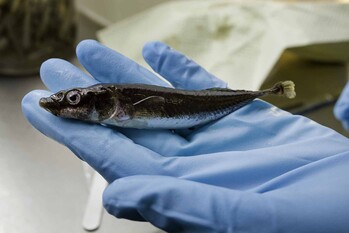 |
Finland is a country of lakes and ponds. Each one can act as an island where populations of some species exist in isolation, creating ideal conditions to study evolution, just like on the Galapagos Islands. (Credit: Handout) | A “giant” nine-spined stickleback from a Finnish pond. Living in ponds without fish predators, the species is responding to their new predators – dragonfly larvae, by outgrowing them. (Credit: Petri Kuokka) |
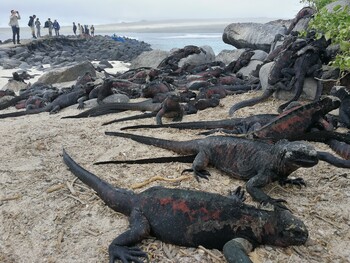 | 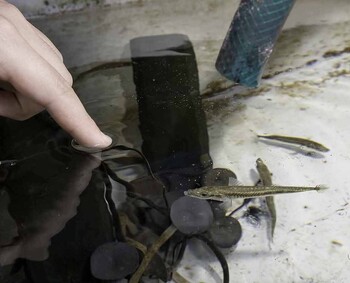 |
Marine iguanas on one of the Galapagos Islands. The species is an example of how an isolated population evolved to become very different from its ancestors. (Credit: Pavel Toropov) | Nine-spined sticklebacks are very common in the Northern Hemisphere, and can live in both the sea and the freshwaters. (Credit: Petri Kuokka) |
 | |
One of the Finnish ponds where Prof Merilä and his team did their research on sticklebacks. (Credit: Juha Merilä) | Professor Juha Merilä in his office. (Credit: Pavel Toropov) |


